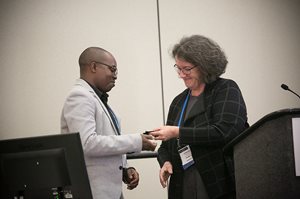 |
The Magill Eradication Symposium at TropMed17 began with President-Elect Regina Rabinovich, right, awarding a commemorative coin to the first Alan
Magill Fellow, Pedro Aide of Mozambique. |
Another Packed House Honors Alan Magill by Turning out to Support Malaria EradicationThe second annual Alan Magill Symposium on Malaria Eradication took place Monday afternoon at #TropMed17, and in a testament to the enduring influence of the late ASTMH Past President, who died unexpectedly in 2015, and the intense interest in malaria eradication, a cavernous ballroom was once again packed with a standing-room only crowd.
Kim Lindblade
“Honestly, the rest of us can only aspire to a fraction of the admiration that his colleagues had for him,” Kim Lindblade, of the World Health Organization Division of Parasitic Diseases, said of Alan Magill.
She took the audience through the ebb and flow of the WHO’s engagement with malaria eradication, including a period in the 1970s and 1980s that she referred to as “the dark ages,” when there was very little progress. But Lindblade noted that elimination and eradication work is accelerating with renewed interest from the global malaria community. And it’s being energized, she said, by
the new E-2020 initiative that is targeting 21 countries to eliminate malaria by 2020.
Lindblade said the elimination work will require significant support because once countries have driven malaria down to a very low level, traveling that last mile to elimination can be difficult. Political interest in fighting the disease tends to wane, she said, and budgets often decline.
“As you can imagine, the last mile for these countries is going to be a very bumpy road,” she said. “In the last year we already have experienced several outbreaks in the E-2020 countries.”
Lindblade also acknowledged that there are concerns that the focus on elimination in countries with a low burden of disease could draw resources away from countries still experiencing “an intolerable burden of illness and death from malaria” that “cannot be allowed to happen.” Moreover, Lindblade hopes that all malaria endemic countries will draw inspiration from the E-2020 effort because it signals that there is an exit strategy.
“They need a light at the end of the tunnel and that’s what elimination gives,” she said. “We need to make sure that light continues to burn brightly.”
Gerry Killeen
Gerry Killeen of the Liverpool School of Tropical Medicine and the Ifakara Health Institute in Tanzania took the audience through the complicated and vexing world of residual malaria transmission—that persistent, frustrating level of disease that still hangs around even after there is blanket coverage with things like long-lasting insecticide treated bednets and indoor residual spraying.
He said it’s important to celebrate that there are 4 million people walking around alive today because of the scale-up of malaria control measures like bednets. But, he added, it’s also important to be realistic that residual malaria transmission still represents a significant level of infection.
Residual transmission, he said, is a “monster that is scary to look in the eye” because “it’s not going away no matter how many bednets you throw at it.”
He said dealing with residual malaria requires more creative thinking around vector control strategies and being willing to accept a certain amount of “market fragmentation” in the interest of developing solutions tailored to specific locales. Killeen also said that his years living and working in Tanzania have shown him that it will be especially important to look to Africans for innovations.
Clara Menendez
Clara Menendez of the Barcelona Institute for Global Health spoke to the complex challenge of mounting an aggressive malaria elimination campaign that includes mass drug administration—while taking into account the potential danger certain malaria medications could pose for pregnant women.
She said there have been times when the question of women of child-bearing age during malaria elimination has been neglected and ignored. And she acknowledged that dealing with the issue is “a little bit of an inconvenience that may interfere with the smooth running of an intervention plan.”
Menendez described a mass drug administration strategy developed as part of Mozambique’s elimination plan that includes pregnancy testing and selecting medications based on the stage of pregnancy. Women are also counseled about potential risks so they can make an informed decision about whether or not to participate, she said.
“If a drug is not recommended to be given in the first trimester of pregnancy, and most are not, we should provide an opportunity for pregnancy tests and screening,” Menendez said. “It is challenging but it can be done.”
Ivo Mueller
Ivo Mueller of the Institute Pasteur reminded the audience that if they think eliminating
P. falciparum, the predominant form in Africa, is difficult, they should understand that
P. vivax is far more challenging. A key problem, he said, is
P. vivax parasites cause an average of four relapsing episodes of malaria for every one infection. And each relapse—which frequently produce no symptoms— presents another opportunity to transmit more malaria into the local mosquito population.
But he noted that, while it’s a difficult wipeout, it’s clearly possible. “We have eliminated
vivax from large parts of the world. Every single country that is malaria-free has had
vivax malaria,” he said.